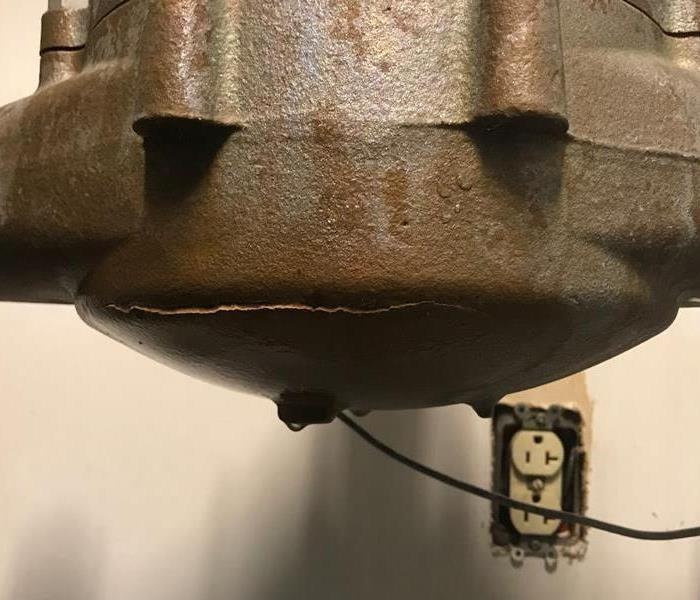Ways to Prevent Water Damage to your Property...
2/11/2019 (Permalink)
Water can and will find its way into any opening it can, sometimes even creating the opening itself. Taking small preventative measures and properly maintaining your home can help save you money, time and irreplaceable heirlooms. Here are some steps you can take to protect your home or business from unwanted water damages, repairs and insurance claims.
EXTERIOR PREVENTATIVE MEASURES:
- Ensure proper drainage from your foundation. This includes ensuring your landscaping slopes away from the foundation of your home or building and any drainage pipes are set correctly and are not damaged. It also means you need to keep your gutters cleaned out throughout the year and that the downspouts are at least five to ten feet away from the structure to ensure the water will flow away from it. Installing gutter guards is often a good measure to help prevent the gutters from getting clogged with leaves and other debris.
- Inspect your roof semi-annually. Checking the integrity of the roof’s structure itself and ensuring the shingles are all secure and check for algae, moss or lichen buildup, maybe even consider having your roof cleaned professionally.
- Keep your crawlspace puddle free. If you have a crawlspace, it is important to ensure you do not have any water puddling underneath your floor so a damp environment that will lead to the development of mold, rot, mildew or insects doesn’t occur.
- Maintain trees and vegetation. It is important to know where your utility lines and/or pipes run underground to ensure your trees and shrubs do not damage them with their roots. Some species are very invasive and will grow right into your sprinkler system, drainage fields, pipes and septic tanks. A safe distance for invasive species in usually about 20 feet from the pipes or house, otherwise 10 feet is usually a safe distance for clearance.
- Check Sprinkler and Irrigation systems. Check your irrigation or sprinkler systems to make sure they are not leaking and pooling water near the foundation or damaging the siding of your home. ALWAYS ensure you have disconnected and winterized your lines for states that have freezing winters.
- Cracks in the foundation. Concrete cracks, it is inevitable. You should periodically check your foundation for cracks. If it is a minor crack, concrete caulk, if it is a little bit larger crack, then a concrete patch should suffice. You should also ensure it is not being caused by a more serious problem, such as invading roots, which can cause you to need professional help.
INTERIOR PREVENTATIVE MEASURES:
- Always know where your water main is located! This can keep any interior flooding to a minimum as you can turn it off from the main source and allow yourself time to locate where the leak is coming from.
- Maintain your appliances. Sometimes our appliances can malfunction or become old and have issues and if they use water, it can lead to a flooded room. Checking your appliances routinely will help reduce any undetected leaks and damage.
- Install floor/drain pans. Using a floor or drain pan can help prevent a minor leak from causing significant damages.
- Upgrade your washing machine hoses. Washing machine leaks are among the most common causes for water damage losses in homes. It is recommended to replace your washing machine hose every 5 years, even possibly consider getting a flood safe house. If the hoses are old, bent, brittle, crimped or leaking then they should be replaced immediately.
- Inspect your other appliances that may use water. Refrigerators that have ice makers or water dispensers can often have a leaking water line. Water Heaters can rust out and cause leaking as well as faulty water outlets and drain valves. Ensuring these stay maintained will help prevent a water damage loss.
- Air conditioner units are another main source. Usually A/C Units are out of sight, therefore out of mind. It is important to perform regular maintenance and inspect them properly, especially in summer months when they are working overtime.
- Seal all doors and windows. Ensuring the caulking is not cracked and dried out and that the weather stripping is in place will help prevent an avenue water, snow and ice can enter through and cause destruction.
- Inspecting hoses, faucets, sinks and spigots. When checking for leaks it is recommended to check in the cabinets that lie under these areas for any leaks or water staining. Using 100% silicone caulking can help prevent these leaks.
- Monitor your water bill. Keeping an eye on the amount of water you are being billed for use of is an excellent way to notice if there is an increase in fluctuation. An increase that you are not aware of will indicate there is water going somewhere and should prompt you to look for it.
SERVPRO of North Calhoun County is faster to any size disaster and will make it “Like it never even happened.” Call us today for help with your water damage at (269) 963-3033.






 24/7 Emergency Service
24/7 Emergency Service
